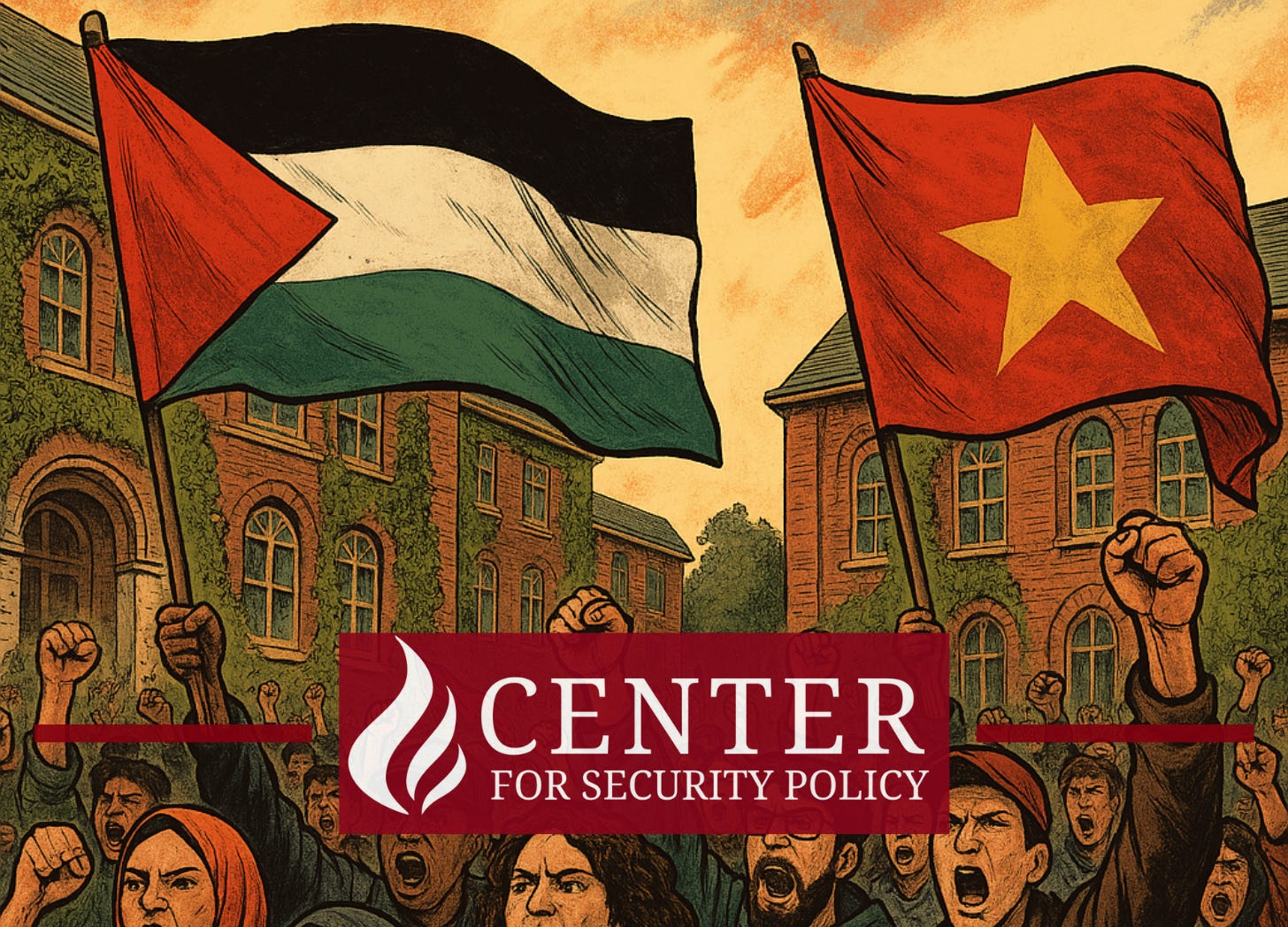Communist Party of Philippines Backing U.S. Encampment Protests: Report
The Center for Security Policy's Kyle Shideler reveals that the CPP has been backing U.S. campus protests after the Hamas Oct 7 attack by mobilizing student groups through its front organizations

A new report written by Kyle Shideler, Director for Homeland Security and Counterterrorism at the Center for Security and Policy, asserts that the Communist Party of the Philippines (CPP) — a U.S.-designated terrorist organization — has played a significant role in supporting civil disorder and campus protests in the United States following the October 7, 2023, Hamas-led invasion of Israel. It highlights the CPP’s involvement through its network of front organizations, mobilizing American student groups in solidarity with Palestinian terrorists.
Additionally, the report highlights contributions from citizen journalist Stu Smith (@thestustustudio) on X, who captured protest training material that documents the methods used to train activists, further reinforcing the evidence of CPP’s direct involvement in shaping protest tactics and strategies.
CPP’s Front Groups and Their Involvement in Protests
According to the report, the CPP operates through front groups like Anakbayan, the student wing of Bagong Alyansang Makabayan (Bayan), and Bayan-USA, which has played a key role in organizing protests across U.S. campuses. While these organizations claim independence, the report details their direct ties to the CPP’s National United Front Commission (NUFC), which is a key CPP organ that oversees and controls various front organizations to ensure alignment with CPP’s political objectives.

The report specifies that the CCP exerts control over these groups through a system of “democratic centralism,” a principle of the CPP’s organizational structure that enforces strict alignment with the party's decisions and objectives. According to the report, the United Front Commission ensures that organizations like Anakbayan USA and Bayan-USA remain ideologically aligned with the CPP’s revolutionary goals and act in coordination with the CPP's broader strategy, which includes mobilizing support for international causes such as Palestinian solidarity, among other Marxist objectives.
The report also asserts that these front groups, although they present themselves as independent and solely focused on issues like Palestine, are fundamentally part of the CPP’s strategy to advance global Marxist revolution. This is evidenced by their support for the NPA (New People’s Army), the armed wing of the CPP, and their public declarations of solidarity with the CPP’s broader revolutionary agenda.
Evidence of Training and Indoctrination
In addition to these training programs, the report references the CPP’s PADEPA program (Pambansang Demokratikong Paaralan, or National Democratic School), an educational initiative tailored to recruit and train activists from various sectors in the U.S. and abroad. Through PADEPA, American students have been indoctrinated with CPP’s cadre training and curriculum. This program focuses on ideological development and mass organizing techniques aimed at preparing activists for their eventual participation in the CPP’s broader revolutionary agenda.
The report provides direct evidence of the CPP’s role in shaping protest strategies by documenting the training programs provided to U.S. activists. One example is a summer program called the “People’s University for Liberated Palestine,” organized by UCLA’s Students for Justice in Palestine (SJP). The report details how this program not only focused on ideological training but also offered practical protest strategies, including how to confront police, organize protests under surveillance, and handle de-arrest operations. The training also included specific sessions on activist tactics and on countering police formations during protests, demonstrating how the CPP has directly influenced protest methods.
Additionally, the report mentions the “Araling Aktibista” program, a curriculum developed by the CPP to teach activists about Marxist theory and organizing methods. This curriculum includes Maoist writings, particularly "The Five Golden Rays," and provides ideological instruction to ensure that activists are aligned with the CPP’s revolutionary goals. These training programs are evidence of the CPP’s deliberate effort to influence and direct protest actions in the U.S.
Ties to Palestinian Terror Groups and Leftist Movements
The report outlines the historical and ongoing connections between the CPP and Palestinian terrorist organizations, including the Popular Front for the Liberation of Palestine (PFLP). These affiliations, the report notes, are not new and have been ongoing since the Cold War. The CPP’s involvement in global groups like the International League of People’s Struggle (ILPS) is noted, with the report emphasizing how these connections help promote anti-imperialist causes.
In 2022, ILPS featured Samidoun and PFLP leader Khaled Barakat at one of their events. In 2024, convicted PFLP hijacked Leila Khalid was a keynote speaker at the League’s 7th International Assembly. This solidarity is connected to the current anti-Israel protests, with the report suggesting that the CPP plays a key role in supporting Hamas’ objectives and radical left-wing movements.
CPP’s Strategy: Subversion through “Red” and “White” Areas
A central theme in the report is the CPP’s strategic framework of “Red” and “White” areas, based on Maoist principles. The report states that “Red” areas are zones of insurgency, while “White” areas are non-revolutionary regions, such as the United States. The CPP uses “White” areas to conduct subversive activities that support revolutionary efforts abroad. These activities aim to destabilize political systems in “White” areas, including the U.S., by aligning protests, such as those in support of Palestinian causes, with broader anti-imperialist and Marxist objectives.

U.S. Counterterrorism and Counterintelligence Approaches
In conclusion, the report critiques the current U.S. counterterrorism strategies, suggesting they fail to fully address the scope of subversion caused by foreign actors like the CPP. It calls for a more comprehensive approach that includes counterintelligence and countersubversion efforts, alongside traditional counterterrorism measures, to adequately respond to these global networks that manipulate U.S. protest movements for revolutionary goals. The CPP’s influence on U.S. campus protests illustrates the need for an expanded national security strategy.




The marxists use the islamists movements but in the nd, as shown by what happened in Iran, they tirn out to be the useful idoots. When the Shah was overthrown in 1979, with the help of the communists, it was the Islamists who grabbed the power and conscientiously killed all the communists. A lesson to be learned!